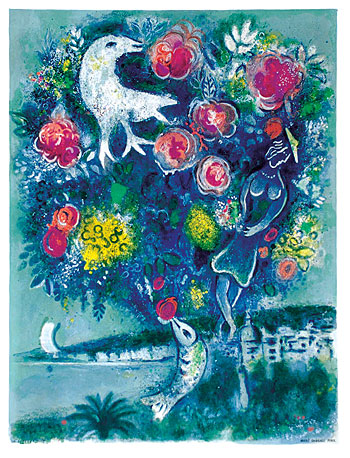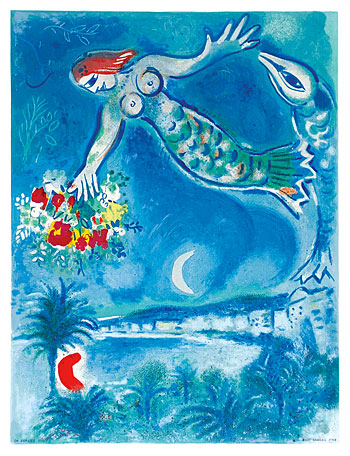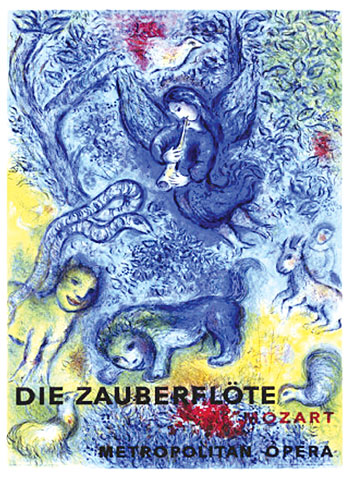 |
Marc Chagall in Nepal? The idea seems almost as incredible as the works of the Belarusian-French genius. Though it may be a while before original paintings of the European masters make their way to Nepal, there's no doubt the opportunity to see a brace of Chagall lithographs and original posters from his exhibitions will be savoured by those who make their way to Yala Maya Kendra at Patan Dhoka from 13-21 November.
It's certain the patients at the Spinal Rehabilitation Injury Centre (SIRC) in Sangha, where these works will be on permanent display once this exhibition is over, will appreciate the exuberant bursts of colour and figures in flight that are Chagall's trademark. The yearning for freedom of movement and expression, in every sense, is pervasive in his paintings. And it was this very yearning, as expressed by a painting of a flying man by a patient at SIRC, that inspired the visiting Meret Meyer to bring a Chagall exhibition to Nepal. He was, after all, her grandfather.
The Magic of Colour, as curators Meyer and J�rg Kunz explain, will convey the message of love and tolerance through a "vocabulary of colour". Looking at Chagall's works, it's not hard to see what they mean. He was born into the Jewish community in Belarus in 1887, then part of the Russian Empire, and barely managed to escape to America from France as Nazism overwhelmed the continent. Meyer and Kunz feel Chagall's cultural openness and religious tolerance will speak to a Nepali audience, "independently of space and time, as well
as of the allegiances and boundaries of the eyes looking at them."
 |
 |
Chirag on Chagall
 |
I wonder how Chagall would have felt had he� known that someday he would have an exhibition of his works in the Kathmandu Valley. He would have been overjoyed, I am sure, because we have in us what he presents in his works. Chagall is all about the joy of colours, about myth and mystery, a sense of exoticness and yet a beautiful simplicity. When we look at Chagall's works, we re-realise how beautiful our dreams can be even if they never metamorphose into reality.
The artist and his wife Bella Rosenfeld flew on his coloured canvases. As Bella happily explained, "Through the window a cloud and a patch of sky called to us. The brightly hung walls whirled around us. We flew over fields of flowers, shuttered houses, roofs, yards, churches." With this exhibition, I see Chagall and Bella flying in Nepali skies and scapes. They float around our stupas and our yellow mustard fields. This is what an artist can do to you �" 25 years after his demise, he can still make you feel the thrill of wonderful things happening.
I love the fact that though Chagall was a pioneer of modernism and one of the greatest figurative artists of the twentieth century, he was deeply rooted to his elements. He loved Fauvism and symbolism as well as the boldness of masses of cubic compositions, yet he created a beautiful, surreal genre of his own.
In 1952, Pablo Picasso was quoted thus: "After Matisse dies, Chagall will be the only painter left who understands what colour really is." With this exhibition, the great artist not only presents to us his motifs, but all the colours he loved so much. His palette has always been vibrant, and the happiness that his art exudes is contagious.
Chagall would have loved our villages and our fields. It is the post-monsoon harvest season, the light is strong and the colours bright in the hills and plains of Nepal. With his spiritual inclinations, he would certainly have visited the temples, stupas and bihars of the Kathmandu Valley towns. Perhaps he would have been inspired to design a carved wooden window or two! He would have loved the symbolic content of our spiritual and religious arts just as he would have appreciated the innocence, as well as the lightly carried wisdom, of our folk arts.
Chagall has now come to Nepal with this exhibition. His jubilant colours and motifs invite us to celebrate life and love. He certainly would have known that this is exactly what we need, at this time and place.
Chirag Bangdel
Artist and writer


